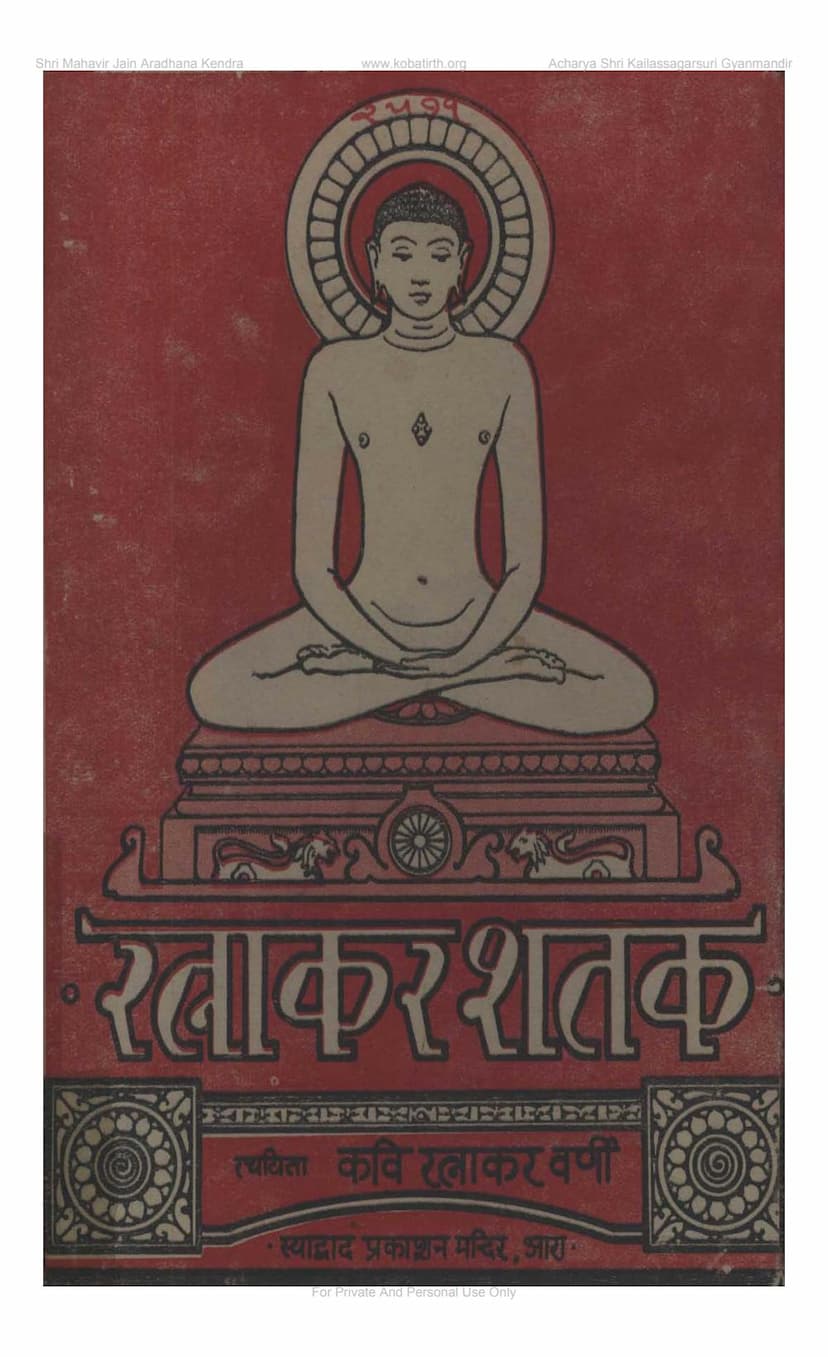Ratnakar Pacchisi Ane Prachin Sazzayadi Sangraha
Added to library: September 2, 2025

Summary
Here's a comprehensive summary of the Jain text "Ratnakar Pacchisi Ane Prachin Sazzayadi Sangraha" by Umedchand Raichand Master, based on the provided pages:
Title: Ratnakar Pacchisi Ane Prachin Sazzayadi Sangraha (Collection of Ratnakar Pacchisi and Ancient Hymns)
Author: Umedchand Raichand Master
Publisher: Umedchand Raichand Master
Core Subject: The book is a collection that includes the "Ratnakara Shataka" (a work by the poet Ratnakar Varni) and other ancient Jain hymns. The provided text specifically focuses on the introduction, preface, and the beginning verses of the "Ratnakara Shataka," with extensive commentary.
Key Themes and Content:
-
The Importance of Jain Literature and its Preservation:
- The preface laments the slow pace of publication and promotion of Digambara Jain literature compared to Shvetambara literature.
- It highlights the need to bring out the rich ancient and modern Jain literary heritage for the benefit of society.
- The establishment of the "Shri Deshabhushan Syadvada Granthamala" and "Shri Syadvada Prakashan Mandir" in Ara is mentioned as an effort to achieve this.
-
The "Ratnakara Shataka": An Spiritual Exposition:
- The "Ratnakara Shataka" is described as a spiritual work in Kannada, authored by the great poet Ratnakar Varni.
- It is part of a trilogy by Ratnakar Varni, which also includes "Ratnakaradhiśvara Shataka," "Aparajita Shataka," and "Trailokyeśvara Shataka."
- The "Ratnakaraśataka" itself is the "Ratnakaradhiśvara Shataka," which primarily deals with detachment (vairagya), ethics (niti), and the true nature of the soul (atma-tattva).
-
Spiritual Philosophy and Self-Realization (Soul's Nature):
- Renunciation of the Body and Attachment to External Adornments: The initial verses strongly condemn attachment to the physical body and external decorations (like clothes, jewelry, perfumes). The body is described as impure and its adornment is futile. True adornment lies in the "three jewels" (Ratnatraya): Right Faith (Samyak Darshan), Right Knowledge (Samyak Gyan), and Right Conduct (Samyak Charitra).
- The Nature of the Soul: The soul is described as eternal, indestructible, conscious, knowing, and seeing. It is distinct from the body and all material substances. The soul's inherent qualities are knowledge, perception, bliss, and energy.
- The Path to Liberation: The text emphasizes the importance of "Bhed Vigyan" (discriminative knowledge) – understanding the soul as separate from the body and other substances. This knowledge, combined with the three jewels, is the path to liberation.
- The Cycle of Birth and Death: The text alludes to the endless cycle of rebirth and the suffering it entails, urging readers to utilize the human birth for spiritual advancement.
- The Impermanence of Worldly Possessions: Wealth, youth, family, and worldly power are depicted as transient and ultimately futile.
- The Importance of Devotion: While advocating for self-realization, the text also highlights the role of devotion to the enlightened beings (Panche Parmesthi) as a means to purify the mind and progress on the spiritual path.
- The True Meaning of Dharma: Dharma is not merely rituals or accumulation of merit, but the realization of the soul's true nature, free from passions and attachments.
- The Role of Meditation: Meditation (Dhyana) is presented as a crucial practice for soul purification, leading to the realization of the soul's true self and eventual liberation. Various types of meditation, including Dhyana, are discussed.
- The Nature of Karma: The text explains the principles of karma, its bondage, cessation, and elimination, emphasizing that the soul is the creator and experiencer of its own karma.
-
The Poet Ratnakar Varni:
- The introduction provides biographical details about Ratnakar Varni, noting his literary prowess and his time period (16th century).
- It touches upon legends and anecdotes from his life, including his association with a king and his eventual return to Jainism after a period of deviation.
-
Commentary and Explanation:
- A significant portion of the text is dedicated to detailed commentary (Vivechan) on each verse, explaining the spiritual and philosophical concepts in depth.
- The commentary draws from various Jain scriptures and philosophical traditions to elucidate the teachings of the "Ratnakara Shataka."
- The author, Umedchand Raichand Master, explains the importance of each verse in the context of Jain spiritual practice.
Key Concepts Elaborated:
- Dravya (Substance), Guna (Attribute), and Paryaya (Mode): The fundamental categories of Jain metaphysics are explained.
- Six Dravyas: Jiva (soul), Pudgala (matter), Dharma (medium of motion), Adharma (medium of rest), Akasha (space), and Kala (time).
- Five Astikayas: Jiva, Pudgala, Dharma, Adharma, and Akasha (these are the substances that have spatial extension).
- Seven Tattvas: Jiva, Ajiva (non-soul), Asrava (influx of karma), Bandha (bondage of karma), Samvara (cessation of karma), Nirjara (shedding of karma), and Moksha (liberation).
- Nayas (Standpoints): The text discusses different epistemological standpoints like Nischaya Naya (ultimate truth) and Vyavahara Naya (conventional truth) to explain complex spiritual concepts.
- The Three Jewels (Ratnatraya): Right Faith, Right Knowledge, Right Conduct, as the path to liberation.
- Karma Theory: Detailed explanation of karmic bondage, its types, effects, and the process of shedding karma.
- Types of Meditation: Ardha, Raudra, Dharma, and Shukla Dhyana.
- The Twelve Bhavanas (Meditations/Reflections): Anitya (impermanence), Asharana (helplessness), Samsara (cycle of existence), Ekattva (aloneness), Anyatva (otherness), Ashuchi (impurity), Asrava (influx), Samvara (stoppage), Nirjara (shedding), Loka (world), Bodhi-durlabha (rarity of right knowledge), and Dharma (righteousness).
- Death (Marana): Different types of death and the importance of Samadhi Marana (peaceful death with equanimity).
- Charity (Dana): The significance and types of charity, emphasizing Gyan Dana (knowledge donation).
- Tapas (Austerities): The importance and types of austerities for spiritual purification.
Overall Purpose:
The book aims to disseminate the profound spiritual teachings of Jainism, particularly those expounded by Ratnakar Varni, to a wider audience through Hindi translation and detailed commentary. It serves as a guide for spiritual seekers, encouraging detachment from worldly affairs and focusing on the realization of the soul's true nature for ultimate liberation. The effort is also a contribution to the preservation and propagation of precious Jain literature.